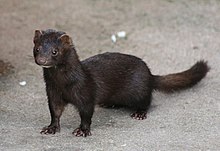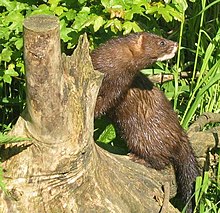This article needs additional citations for verification. (February 2017) |
| Mink | |
|---|---|

| |
| American mink (Neogale vison) | |
| Scientific classification | |
| Domain: | Eukaryota |
| Kingdom: | Animalia |
| Phylum: | Chordata |
| Class: | Mammalia |
| Order: | Carnivora |
| Family: | Mustelidae |
| Subfamily: | Mustelinae |
| Species included | |

(Mustela lutreola)
Mink are dark-colored, semiaquatic, carnivorous mammals of the genera Neogale and Mustela and part of the family Mustelidae, which also includes weasels, otters, and ferrets. There are two extant species referred to as "mink": the American mink and the European mink. The extinct sea mink was related to the American mink but was much larger.
The American mink's fur has been highly prized for use in clothing. Their treatment on fur farms has been a focus of animal rights and animal welfare[1] activism. American mink have established populations in Europe (including Great Britain and Denmark) and South America. Some people believe this happened after the animals were released from mink farms by animal rights activists, or otherwise escaped from captivity.[2][3] In the UK, under the Wildlife and Countryside Act 1981, it is illegal to release mink into the wild.[4] In some countries, any live mink caught in traps must be humanely killed.[5]
American mink are believed by some to have contributed to the decline of the less hardy European mink through competition (though not through hybridization—native European mink are in fact more closely related to polecats than to North American mink).[6] Trapping is used to control or eliminate introduced American mink populations.[7]
Mink oil is used in some medical products and cosmetics, as well as to treat, preserve, and waterproof leather.
- ^ "Dutch minister reverses battery and mink ban. (Netherlands).(Defeat f…". 29 January 2009. Archived from the original on 29 January 2009.
- ^ "Animal rights group claims responsibility for mink release". BBC News. 9 August 1998.
- ^ "Mink in Britain | Learn about American Mink in the UK – Game and Wildlife Conservation Trust". www.gwct.org.uk. Retrieved 20 April 2021.
- ^ "Wildlife and Countryside Act 1981". Legislation.gov.uk. Retrieved 28 February 2017.
- ^ "Dispatching a live-caught mink - Game and Wildlife Conservation Trust". Gwct.org.uk. Retrieved 28 February 2017.
- ^ Lodé, T.; Guiral, G.; Peltier, D. (2005). "European mink-polecat hybridisation events: hazards from natural process?". Journal of Heredity. 96 (2): 1–8. doi:10.1093/jhered/esi021. PMID 15653561.
- ^ Haworth, Jenny (3 February 2009) "National cull may exterminate UK mink". Edinburgh. The Scotsman.